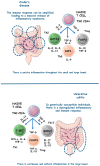Medicinal Plants, Phytochemicals and Regulation of the NLRP3 Inflammasome in Inflammatory Bowel Diseases: A Comprehensive Review
- PMID: 37367886
- PMCID: PMC10305268
- DOI: 10.3390/metabo13060728
Medicinal Plants, Phytochemicals and Regulation of the NLRP3 Inflammasome in Inflammatory Bowel Diseases: A Comprehensive Review
Abstract
Ongoing research explores the underlying causes of ulcerative colitis and Crohn's disease. Many experts suggest that dysbiosis in the gut microbiota and genetic, immunological, and environmental factors play significant roles. The term "microbiota" pertains to the collective community of microorganisms, including bacteria, viruses, and fungi, that reside within the gastrointestinal tract, with a particular emphasis on the colon. When there is an imbalance or disruption in the composition of the gut microbiota, it is referred to as dysbiosis. Dysbiosis can trigger inflammation in the intestinal cells and disrupt the innate immune system, leading to oxidative stress, redox signaling, electrophilic stress, and inflammation. The Nod-like Receptor (NLR) Family Pyrin Domain Containing 3 (NLRP3) inflammasome, a key regulator found in immunological and epithelial cells, is crucial in inducing inflammatory diseases, promoting immune responses to the gut microbiota, and regulating the integrity of the intestinal epithelium. Its downstream effectors include caspase-1 and interleukin (IL)-1β. The present study investigated the therapeutic potential of 13 medicinal plants, such as Litsea cubeba, Artemisia anomala, Piper nigrum, Morus macroura, and Agrimonia pilosa, and 29 phytocompounds such as artemisitene, morroniside, protopine, ferulic acid, quercetin, picroside II, and hydroxytyrosol on in vitro and in vivo models of inflammatory bowel diseases (IBD), with a focus on their effects on the NLRP3 inflammasome. The observed effects of these treatments included reductions in IL-1β, tumor necrosis factor-alpha, IL-6, interferon-gamma, and caspase levels, and increased expression of antioxidant enzymes, IL-4, and IL-10, as well as regulation of gut microbiota. These effects could potentially provide substantial advantages in treating IBD with few or no adverse effects as caused by synthetic anti-inflammatory and immunomodulated drugs. However, additional research is necessary to validate these findings clinically and to develop effective treatments that can benefit individuals who suffer from these diseases.
Keywords: Crohn’s disease; NLR Family Pyrin Domain Containing 3; NLRP3; cancer; inflammasome; inflammation; inflammatory bowel disease; medicinal plants; phytochemicals; ulcerative colitis.
Conflict of interest statement
The authors declare no conflict of interest.
Figures




Similar articles
-
The ethanolic extract of Artemisia anomala exerts anti-inflammatory effects via inhibition of NLRP3 inflammasome.Phytomedicine. 2022 Jul 20;102:154163. doi: 10.1016/j.phymed.2022.154163. Epub 2022 May 10. Phytomedicine. 2022. PMID: 35597027
-
Hydroxytyrosol alleviates dextran sodium sulfate-induced colitis by inhibiting NLRP3 inflammasome activation and modulating gut microbiota in vivo.Nutrition. 2022 May;97:111579. doi: 10.1016/j.nut.2021.111579. Epub 2021 Dec 26. Nutrition. 2022. PMID: 35248848
-
NLRP3 Inhibitors as Potential Therapeutic Agents for Treatment of Inflammatory Bowel Disease.Curr Pharm Des. 2017;23(16):2321-2327. doi: 10.2174/1381612823666170201162414. Curr Pharm Des. 2017. PMID: 28155620 Review.
-
Development, validation and implementation of an in vitro model for the study of metabolic and immune function in normal and inflamed human colonic epithelium.Dan Med J. 2015 Jan;62(1):B4973. Dan Med J. 2015. PMID: 25557335 Review.
-
The Nlrp3 inflammasome: contributions to intestinal homeostasis.Trends Immunol. 2011 Apr;32(4):171-9. doi: 10.1016/j.it.2011.02.002. Trends Immunol. 2011. PMID: 21388882 Free PMC article. Review.
Cited by
-
Inflammasomes Are Influenced by Epigenetic and Autophagy Mechanisms in Colorectal Cancer Signaling.Int J Mol Sci. 2024 Jun 3;25(11):6167. doi: 10.3390/ijms25116167. Int J Mol Sci. 2024. PMID: 38892354 Free PMC article. Review.
-
Metabolic-Associated Fatty Liver Disease: The Influence of Oxidative Stress, Inflammation, Mitochondrial Dysfunctions, and the Role of Polyphenols.Pharmaceuticals (Basel). 2024 Oct 10;17(10):1354. doi: 10.3390/ph17101354. Pharmaceuticals (Basel). 2024. PMID: 39458995 Free PMC article. Review.
-
Houttuynia cordata-Derived Exosome-Like Nanoparticles Mitigate Colitis in Mice via Inhibition of the NLRP3 Signaling Pathway and Modulation of the Gut Microbiota.Int J Nanomedicine. 2024 Dec 27;19:13991-14018. doi: 10.2147/IJN.S493434. eCollection 2024. Int J Nanomedicine. 2024. PMID: 39742094 Free PMC article.
-
Antcin-H, a natural triterpene derived from Antrodia cinnamomea, ameliorates dextran sulfate sodium-induced colitis in mice by inhibiting the NLRP3 inflammasome.J Tradit Complement Med. 2024 Mar 30;15(4):343-355. doi: 10.1016/j.jtcme.2024.03.016. eCollection 2025 Jul. J Tradit Complement Med. 2024. PMID: 40677541 Free PMC article.
-
Immunological dimensions of neuroinflammation and microglial activation: exploring innovative immunomodulatory approaches to mitigate neuroinflammatory progression.Front Immunol. 2024 Jan 8;14:1305933. doi: 10.3389/fimmu.2023.1305933. eCollection 2023. Front Immunol. 2024. PMID: 38259497 Free PMC article. Review.
References
-
- Pereira R.B., Rahali F.Z., Nehme R., Falleh H., Jemaa M.B., Sellami I.H., Ksouri R., Bouhallab S., Ceciliani F., Abdennebi-Najar L., et al. Anti-inflammatory activity of essential oils from Tunisian aromatic and medicinal plants and their major constituents in THP-1 macrophages. Food Res. Int. 2023;167:112678. doi: 10.1016/j.foodres.2023.112678. - DOI - PubMed
Publication types
LinkOut - more resources
Full Text Sources

